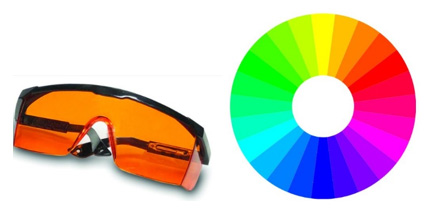I recently took an Eye Health continuing education class. It was excellent and I got caught up on the latest. I learned some interesting and useful science about the eyes. Macular degeneration is the leading cause of vision loss in Americans 60 years of age and older. Luckily it is a “nutrition responsive disorder”.
What is a Macula
The macula acts as a color filter through which light passes before it is perceived by the rods and cones in your retina. It is responsible for some VERY important stuff:
- Our central vision
- Most of our color vision
- The fine detail of what we see
What Damages the Macula
Blue light comes from our light bulbs, computers and also the sun creates free radicals which damage the tissue. Blue light creates reactive radicals (free radicals) in the retina damaging essential tissues.
Lack of eye resiliency that comes with age and poor nutrition.
Macular pigments lutein and zeaxanthin quench free radicals and actively protect the macula’s nerve tissue from the damage
Orange Blocks Blue
If you’ve seen blue blocking glasses, you know that blue blocking glasses range from yellow to dark orange. This makes sense, blue and orange are opposite each other on the color wheel.

Pigments from Food get Embedded in your Macula
Some plants contain yellow/orange/red pigments such as lutein and zeaxanthin which then get embedded directly in the eye and directly contribute to your vision.
To filter blue light, eat yellow-orange-red foods
Being Proactive
Macular degeneration is a “nutrition responsive disorder”. The National Eye Institute has undertaken two Age-Related Eye Disease Studies (AREDS) showing that specific nutrients can slow the progression of the disease.
NIH Conducted a Study which Created a Supplement
AREDS – Age-Related Eye Disease Studies by NIH. Enrolled for thant 5,000 people with age-related macular degeneration (AMD), ended in 2001. Showed that a specific formula of nutritional supplements containing high doses of antioxidants and zinc could slow the disease in those who have intermediate AMD and those with advanced AMD in only one eye.
Follow-up study AREDS2 published in 2013 substituted lutein and zeaxanthin for beta-carotine. Results showed that the AREDS2 combination reduced the risk of disease progression by as much as 19 percent and/or of vision loss by 25 percent.
Not all AREDS Supplements are the Same
After taking the class, I wanted to start an eye health product and be able to recommend one to my patients.
In a recent medical journal researchers compared 11 brand-name supplements and found that many of the products were lacking. Here’s the product I decided on for myself and to share with my patients:

To order using Fullscript https://us.fullscript.com/protocols/boisenaturalhealth-eye-health
Sources and Resources
